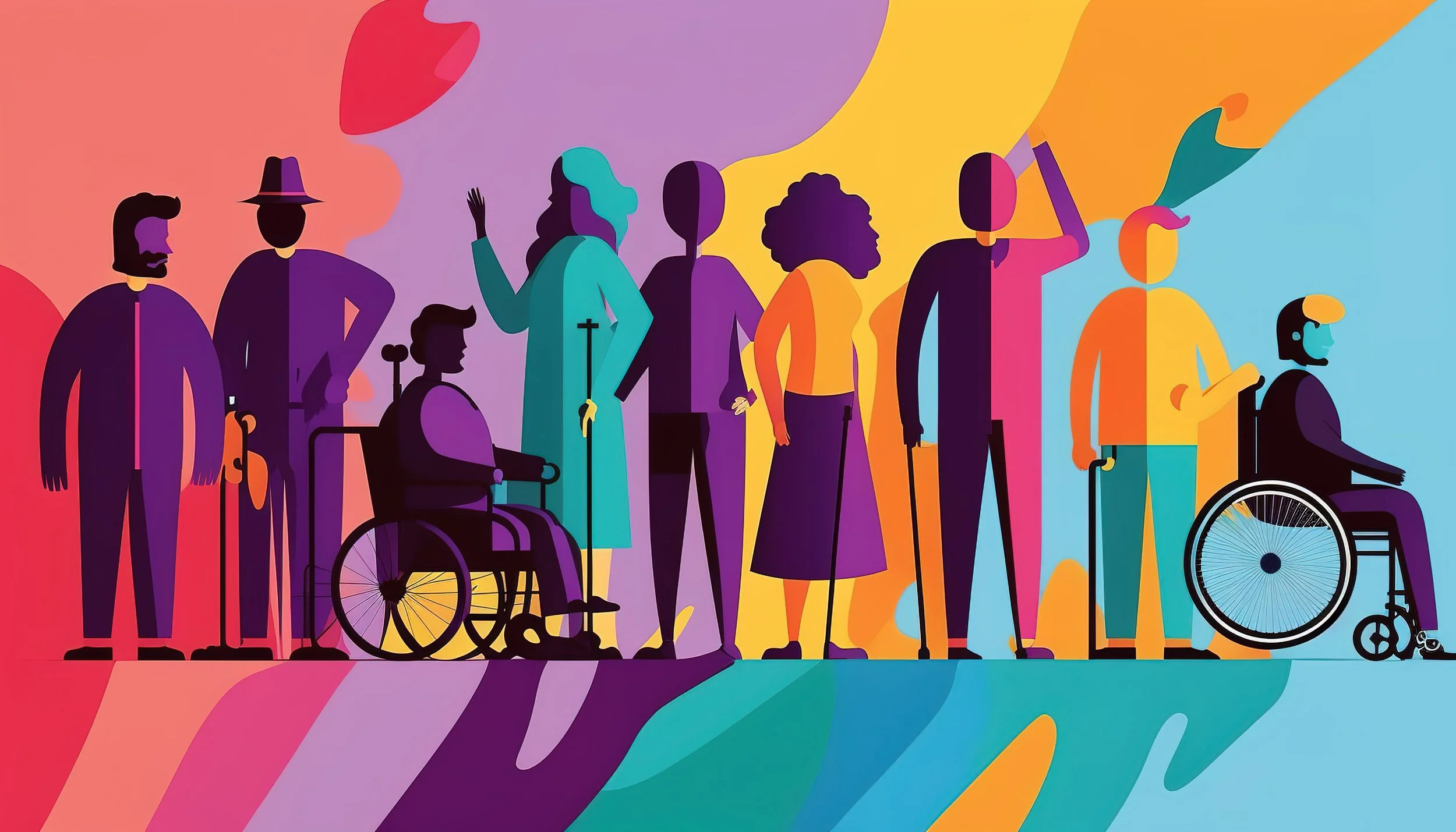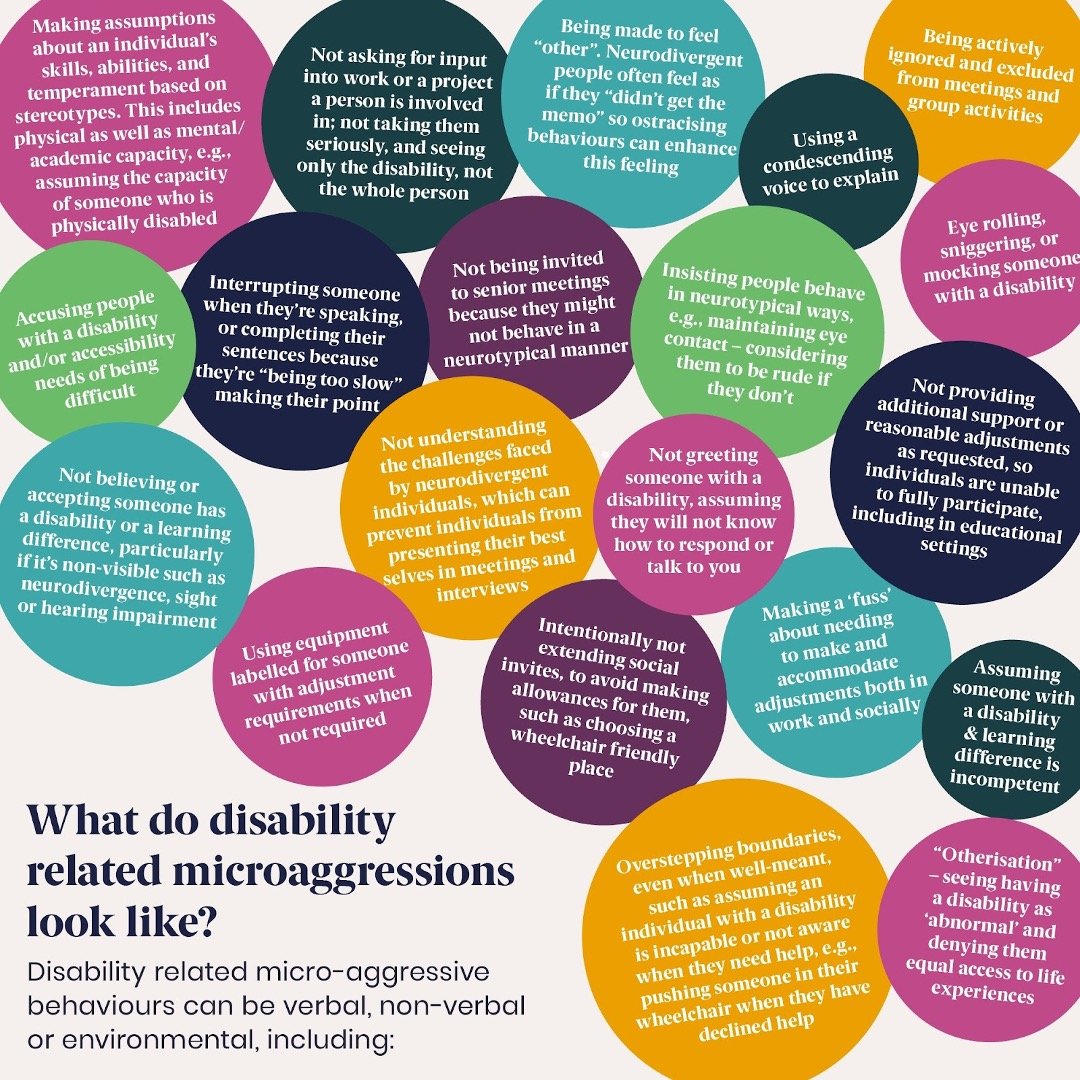As leaders, we have the foremost responsibility to pioneer disability inclusion in our workplaces. I’ll be the first to admit that this goal is easier said than done, but fortunately, there are a multitude of steps we can take to accomplish this crucial aim! In this blog, I will be walking us through six key areas leaders can invest in to demonstrate disability inclusion. Ready to jump in?
1. Inclusive Behavior
Just like anyone else, leaders must embody inclusive behavior toward people with disabilities, because if we aren’t walking the walk, how else will we be able to implement more robust disability initiatives into our organization? As such, there are three crucial inclusive behaviors that leaders should embody:
Listen. That’s right, simply listen! When an employee comes to us with concerns about disability, we can emphasize inclusion and belonging to them by paying attention to how they describe their symptoms, e.g. how their disability impacts their work experience. Additionally, we can also take the initiative to do supplementary research on their description of their disability—not to assume we “know” their experiences, but merely to increase our knowledge and understanding in an area we may not be deeply familiar with.
Confidentiality. If our employees request confidentiality regarding their discussion of the disability, we should grant them that privacy to the extent of our ability. We must not resist their request for confidentiality, and I additionally advise that leaders explicitly articulate that they will not disclose details of conversations regarding the employee’s disability to their fellow team members or to anyone else in the organization. There are exceptions to this confidentiality, such as when leaders may be obligated to report something to HR; if this situation arises, leaders should directly inform their employee that they have this reporting responsibility.
Support. The Harvard Business Review conducted a study regarding workplace attitudes regarding disability, and they found that managers who asked employees with disabilities “‘How do I set you up for success?’” and/or “‘What can I, as a manager, do to support you to perform your best?’” were perceived as “92% more approachable by their team.” In other words, ask employees with disabilities what they need! Ask what support they require to perform their best work! Sometimes the simplest strategies are the most effective ones, and embodying inclusive behavior is a key tactic any leader can implement to foster a safer, more welcoming workplace for people with disabilities.
2. Physical Accommodations
Felicia has had intense back issues since she was a young child, a disability that has only intensified as she got older. As such, it is difficult for her to remain sitting for long periods of time, a challenge that perhaps unsurprisingly often rears its head at work. She asked for a special chair from HR to help minimize the intense pain she experienced while sitting, but her department refused. Why? Under claims of “cost-cutting,” meaning they allegedly would not be able to afford a new chair. Upon asking to work from home, an environment that would give her greater flexibility to manage her disability alongside her job, the department refused: “We treat all of our employees equally. That means you need to be in the office.”
Every time I tell this story, I find myself getting angrier, because the logic Felicia’s department employed in this decision is devastatingly flawed. While perhaps demanding all employees work in-office may technically qualify as the imposition of “equality” (in a limited sense), it by no means produces truly equal outcomes, as Felicia experiencing constant pain while working (a situation that could be easily resolved through a simple accommodation of a specific chair!) does not put her on “equal” ground with the rest of her team—in fact, it puts her at a direct disadvantage.
Additionally, the rhetoric of cost-cutting is not one that leaders and organizations should be invoking with regard to disability accommodations. Heidrick & Struggles, an international executive search and management consulting company with global renown, puts it more succinctly than I ever could:
“A common concern cited by management is the potential cost of providing accommodations—but this fear is largely unfounded. Studies have shown that the cost of providing accommodations is actually quite low, at a median of $600. That’s because many of the accommodations needed—such as flexible schedules and allowing employees to work remotely—cost nothing. Even the cost of software, ergonomic chairs, and other physical accommodations is relatively small. The phenomenal strides that have been made in assistive technology, such as talk-to-text software, have made these kinds of technology accommodations not only highly effective but also very cost-effective.” (emphasis added)
In short, the notion of cost-cutting need not be applied to disability accommodations, simply because disability accommodations do not incur tremendous costs in the first place.
I start with this anecdote regarding Felicia’s frustrating experience to segue into the second key areas leaders can invest in to demonstrate disability inclusion: providing physical accommodations! While the specific accommodations individuals with disabilities may require is as varied as humanity itself, the following are some useful starting points that any leader can offer to reinforce the importance of disability inclusion to their workplace:
Provide interpreters, closed captions, and transcriptions for people with hearing disabilities
Provide opportunities for quiet workspaces and/or noise-canceling headphones as well as adjustable lights in offices for people who work better in dimmer settings (these accommodations can help prevent sensory overload, which disproportionately impacts people with autism, ADHD, and other mental disabilities)
Have multiple ramps, elevators, accessible bathrooms, and automatic doors to help ensure wheelchair users and other people with physical disabilities can comfortably navigate the work building
Ensure all digital content (websites, mobile apps, etc.) is compatible with screen readers as well as other assistive technology, e.g. all images should be accompanied with image descriptions
Use programs (e.g. Microsoft’s System-Wide Live Captions) that generate captions for all visual-auditory material, though have employees on hand who can proofread/correct these captions
Use easy-to-read fonts across written content (such as dyslexic-friendly typefaces!) and ensure there is high contrast between the text and any background colors
Do more than “allow” emotional support animals or service animals in the workplace, e.g. ensure employees can adjust their breaks accordingly to take care of their service animal
Again, the above strategies are but a few starting points with regard to physical, in-person workplace accommodations for disability. When in doubt, go back to the first section of this blog—ask employees what accommodations they need and listen to what they say!
3. Remote Work, Flexible Scheduling, and Workplace Support
Mary has severe arthritis. For years, she worked her job virtually from home, and this set-up was ideal for her! She used a speech-to-text app to avoid strenuous typing, for example, an accommodation that ensured she was able to regularly communicate with her team without causing herself undue pain. In fact, Mary didn’t actually disclose her disability to her manager at first, in part because she was afraid of the bias and discrimination she might encounter even though the accommodations she provided herself mitigated the majority of remote work-related issues she might face.
Now, however, her employers are requiring everyone to come to work in-person three days a week. This requirement puts undue stress on Mary, because her arthritis tremendously increases the amount of time it takes her to get ready in the morning, to get in the car and drive to the office, and so forth. For an able-bodied individual, getting into work at 9 might require waking up at 7. For Mary, getting into work at 9 might require waking up at 5. As such, it’s clear Mary’s manager and the broader department did not take her disability—and likely that of many others’—when implementing this in-person work requirement.
Remote work is thus an excellent opportunity for demonstrating disability inclusion. With regard to Mary’s situation, remote work acts as a measure of equity: because her preparatory commute to an in-person workplace is intensified by her arthritis, she is more drained of energy prior to even starting her shift than a non-disabled employee would be. Remote work helps prevent her from experiencing undue pain and thus ensures she can do her best work for her company!
Flexible scheduling is a similarly inclusive practice for people with disabilities that leaders can implement, i.e. giving employees direct control over when and where they work. This practice can help people with chronic health conditions balance work with numerous doctor’s appointments, for example, as well as may simply be beneficial to people who are primary caregivers, be it for family members with disabilities, elderly parents, children, etc.
Another inclusive practice toward people with disabilities that I am personally quite fond of is the concept of disability allies, i.e. individuals—and especially leaders—in an organization who are specifically designated as resources for people with disabilities (be it because they require an accommodations, need a confidant to speak with, or otherwise could use assistance). Similar to the Safe Space program, disability allies can have some form of an identifiable marker(s) that designates their position as an ally for people with disabilities, e.g. a sticker on their office door, a line in their email signature, and/or an icon on their employee badge. Recruiting people to be disability allies provides multiple benefits: it ensures a guaranteed supported system for people with disabilities; it gives other employees a sense of purpose and an actionable means of demonstrating their allyship; and it helps foster an inclusive culture in the broader organization. Win after win!
4. Planning and Hiring
A friend of mine who has a mobility disability—she walks with a cane—recently visited me to see the full eclipse over Texas. When she had to fly back home, she requested a wheelchair at the airport, as this accessibility measure would make her travel experience less painful. When she got to the airport, however, there was no wheelchair waiting for her, and worse, no clear location for where to go to receive her wheelchair. When she asked an airport employee, she was told she had to wait in line, and moreover to wait for them to bring a wheelchair to her.
My friend waited for half an hour, during which time there was no chair for her available to sit on. For thirty minutes, my friend was simply standing and waiting, in constant pain the whole while! She eventually asked the airport employee at the desk if there was a way for individuals to perhaps be assigned a number, that way they could sit as needed and be called back when a wheelchair was ready for them, and the only response the employee had was: “I don’t have the authority to answer these questions.”
I share this story not to condemn this airport but rather to highlight an almost certain truth that undergirds my friend’s experience: there were no people with disabilities involved in this planning process regarding how airport customers received wheelchairs. The consequence? People with disabilities end up experiencing undue pain for an accommodation that is supposed to directly assist them!
In other words, another key tactic leaders can employ to foster disability inclusion is to get employees with disabilities involved in all planning. That’s right—planning for anything and everything! If a person with a disability may require access to a certain facility or event or program, then people with disabilities should be involved in preparing and executing said processes to ensure maximum accessibility.
A good example is getting people with disabilities involved in organizing events with food, as food is one the most common staples in any workplace event, and yet food intolerances and allergies are also one of the most common disabilities that individuals experience. Because “[s]ymptoms of food intolerance are often very personal, and employees might think twice before volunteering information that can leave them vulnerable to stigma or ridicule at work,” leaders should not default to assuming that their employees will disclose their food sensitivities. Instead, they should create opportunities for individuals to report food allergies/intolerances/etc., be it directly or anonymously, as well as get individuals with disabilities involved in the planning process to help create a more inclusive menu.
Relatedly, individuals with disabilities should be involved in hiring processes to ensure their organization is taking a disability-inclusive approach to hiring! Tips for inclusive hiring toward people with disabilities that leaders can implement include:
Offer at least two ways for job seekers to contact a company, e.g. by phone and email, to accommodate for individuals who might have visual or hearing disabilities
Emphasize on the company website, job postings, career pages, etc. that disability accommodations are available to employees
Guarantee that job applications are compatible with assistive technologies (e.g. screen readers)
During the interview process, integrate “universal design principles,” such as “sign language interpreters, accessible spaces[,] or video interviews for remote applicants”
If employees with disabilities and/or job seekers with disabilities recommend additional accommodations during the hiring process, be sure to listen to them!
5. Promotions and Partnerships
I have spoken many times about the importance of leadership creating talent pipelines, mentorship opportunities, and community partnerships with diverse organizations to help pioneer workplace inclusion, and this same emphasis applies to disability inclusion. It’s not enough to simply hire people with disabilities; they must also have copious opportunities for growth and support, too!
For example, implement mentorship programs for employees with disabilities, pairing them with someone who is familiar with accessibility resources for individuals with disabilities as well as someone who can provide the best guidance to ensure the employee under their wing thrives. Sponsorship programs are similarly beneficial, as they make space for individuals with disabilities to progress in the workplace with less risk of unconscious ableism restricting their opportunities.
External partnerships are also ideal for leaders to demonstrate comprehensive disability inclusion! Community partnerships with disability-centric organizations have the benefit of both “gaining internal support to build a disability-inclusive team” and creating opportunities to “reach potential employees with disabilities.” Leaders can consider looking for their local chapters of national disability nonprofits, such as Easterseals and The Arc!
6. Accommodation Surveys
Last but certainly not least: leaders can help ensure disability inclusion in their organization through the simple tactic of not generalizing people with disabilities. Disability is a capacious term that encompasses numerous diagnoses and even more lived experiences, where accommodations that may benefit some people with disabilities may not be of any use to others. In turn? Ask individuals what accommodations they require to perform their best work!
(In many ways, this blog always circles back to its first section: listen to people with disabilities.)
On one level, it’s crucial for organizations to have “a clearly defined accommodation process and statement for candidates with disabilities to request any needed accommodations.” This process should also be internally available at any point, both during onboarding and well after hiring, because individuals may need to request an accommodation for a disability acquired well into their career. For more comprehensive accessibility, accommodation requests should be available at least through both phone and email, and should ideally “provide a response within at least 24 hours on next steps.”
I’m more than happy to provide accommodations for my employees with disabilities, some leaders may be thinking, but how can I go about phrasing questions to get the best ideas of what they need and how I can help?
To help ease this valid concern, I have developed five simple questions that any organization can use as a starting point for an employee survey regarding disability accommodations:
What are your accessibility needs?
What in-person and/or remote working strategies have colleagues and employers used in the past that successfully accommodate your needs?
Is there anything HR can do to make your in-person work environment best for you? Examples include a quieter location, dimmable lights, an ergonomic chair, recorded and transcribed instructions, etc.
Are you concerned about working from home, in terms of the internet bandwidth at your house?
Do you have any concerns about missing work for any reason, including family/caregiving needs, disability, and health concerns? If you are comfortable, please explain.
And there we have it! Six key areas that leaders can invest in to demonstrate disability inclusion in their workplaces. What are we waiting for? We’ve got some accessibility practices to implement!
Dima Ghawi is the founder of a global talent development company with a primary mission for advancing individuals in leadership. Through keynote speeches, training programs and executive coaching, Dima has empowered thousands of professionals across the globe to expand their leadership potential. In addition, she provides guidance to business executives to develop diversity, equity, and inclusion strategies and to implement a multi-year plan for advancing quality leaders from within the organization. Reach her at DimaGhawi.com and BreakingVases.com.






















